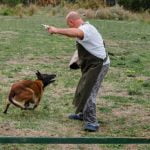Are you wondering how to train your fearful dog? Many dog owners face the challenge of helping their pets overcome fear and anxiety. Understanding the reasons behind fearful behavior in dogs is essential for effective training. Fearful behavior in dogs can impact their ability to learn and interact with their environment. In this article, we will explore the various factors that contribute to fearful behavior in dogs and how it can affect their training process.
Creating a safe and comfortable environment for your fearful dog is crucial for reducing their anxiety and helping them feel secure. This section will provide tips on how to set up a safe space for your dog, including creating a routine, setting boundaries, and providing comforting resources.
Building trust and bonding with your fearful dog is key to helping them feel more secure and confident. Techniques for building trust will be discussed to help create a strong bond between you and your pet.
Positive reinforcement training is highly beneficial for fearful dogs. We will explore how this type of training can help them overcome their fears by rewarding desired behaviors with treats, praise, or toys.
Creating a Safe Environment
When training a fearful dog, creating a safe and comfortable environment is crucial in helping them feel secure and reduce their anxiety. Here are some tips for creating an environment that is conducive to your dog’s emotional well-being:
1. Remove Potential Stressors: Identify any potential stressors in your home that could be contributing to your dog’s fear and anxiety. This could include loud noises, sudden movements, or unfamiliar people or animals. Take steps to minimize or eliminate these stressors to create a calmer environment for your dog.
2. Provide a Safe Space: Designate a specific area in your home where your fearful dog can retreat to when they feel overwhelmed or anxious. This could be a quiet corner with their bed and toys, or a cozy crate that serves as their safe haven.
3. Establish Consistent Routines: Dogs thrive on routines and predictability, so establishing consistent daily routines can help your fearful dog feel more secure. This includes regular feeding times, walks, playtime, and bedtime rituals.
4. Use Calming Strategies: Incorporate calming strategies into your fearful dog’s daily routine, such as playing soothing music, using pheromone diffusers, or providing calming treats or supplements recommended by your veterinarian.
5. Offer Positive Reinforcement: Use positive reinforcement techniques to create a positive association with the safe environment you have created for your fearful dog. Reward them with treats, praise, and affection when they voluntarily spend time in their designated safe space.
By following these tips and creating a safe environment for your fearful dog, you can help them feel more secure and reduce their anxiety as you work on training them to overcome their fears.
Building Trust and Bonding
When it comes to training a fearful dog, building trust and bonding is crucial in helping them feel more secure and confident. Fearful dogs often have experienced trauma or neglect, causing them to be anxious and hesitant around people or new situations. Here are some techniques on how to train your fearful dog by focusing on building trust and strengthening the bond with your pet.
Firstly, it’s important to be patient and understanding when working with a fearful dog. Rushing things can exacerbate their anxiety, so take things slow at their pace. Spending quality time with your dog through gentle interactions, such as calmly talking to them, sitting near them, or engaging in quiet activities together can help build trust over time.
Consistency is key when training a fearful dog. Establishing routines and providing a calm, predictable environment can help them feel more secure. Dogs thrive on routine, so a consistent daily schedule can provide comfort and reassurance for a fearful dog.
Another effective technique for building trust is positive reinforcement. Using treats, praise, and rewards for even small signs of progress can boost their confidence and motivate them during training sessions. For example, rewarding them when they approach new people or objects without showing signs of fear can help reinforce positive behavior.
Using these techniques to build trust and bond with your fearful dog lays the foundation for successful training. When your dog feels safe and trusts you, they are more likely to overcome their fears and become more confident in various situations.
| Technique | Description |
|---|---|
| Patience | Take things slow at the dog’s pace; spend quality time through gentle interactions |
| Consistency | Establish routines; provide a calm, predictable environment |
| Positive Reinforcement | Use treats, praise, and rewards to boost confidence during training sessions |
Positive Reinforcement Training
Positive reinforcement training is a highly effective method for training fearful dogs, as it focuses on rewarding desired behaviors rather than punishing unwanted ones. This approach allows fearful dogs to build confidence and trust, making them more likely to overcome their fears. By using treats, praise, and toys as rewards, you can motivate your fearful dog to engage in positive behaviors and gradually desensitize them to the things that trigger their fear.
One of the key benefits of positive reinforcement training for fearful dogs is that it helps create a strong bond between the owner and the pet. Through this training method, fearful dogs learn to associate their owner with safety and security, which can help reduce their anxiety and fear. Additionally, the use of treats and praise as rewards can boost a dog’s confidence and self-esteem, making them more willing to face challenging situations.
When implementing positive reinforcement training for a fearful dog, it’s important to be patient and consistent. Remember that fearful dogs may take longer to show progress compared to confident ones. It’s crucial to set realistic goals and celebrate small victories along the way. Over time, with patience and perseverance, you will begin to see your dog gain confidence and become calmer in previously scary situations.
| Positive Reinforcement Training Benefits | How It Helps Fearful Dogs |
|---|---|
| Strengthens bond between owner and pet | Builds confidence and trust |
| Promotes positive behaviors without punishment | Reduces anxiety and fear triggers |
| Boosts dog’s confidence and self-esteem | Helps create a safe environment for the dog |
Desensitization and Counterconditioning
Desensitization involves exposing your dog to their fears at a level that is tolerable for them, gradually increasing the intensity of the exposure as they become more comfortable. This gradual approach helps prevent overwhelming your dog and allows them to build confidence over time.
For example, if your dog is afraid of loud noises, you can start by playing recordings of the noises at a very low volume and gradually increase the volume as your dog becomes more accustomed to the sound.
Counterconditioning involves changing your dog’s emotional response to their fears by associating those fears with something enjoyable or positive. For example, if your dog is fearful of strangers, you can have strangers offer treats or play games with your dog to create a positive association with new people. Over time, this can help change your dog’s negative emotional response to a more positive one.
These techniques require patience, consistency, and careful observation of your dog’s behavior. It’s important to start at a level where your dog feels safe and comfortable, and it’s crucial not to rush the process. Gradually exposing your fearful dog to their fears while also providing positive reinforcement can go a long way in helping them overcome their anxieties and build confidence.
- Start desensitization and counterconditioning training at a level where your fearful dog feels safe
- Gradually increase the intensity or exposure as your dog becomes more comfortable
- Always pair exposures with something positive such as treats, toys, or praise
- Be patient, consistent, and observant of your dog’s behavior throughout the process
Proper Socialization
Importance of Socialization
Proper socialization is crucial for all dogs, but it is especially important for fearful dogs. Early socialization helps puppies develop confidence and adaptability, making them less likely to develop fearful behavior later in life. For older dogs who are already exhibiting fearful behavior, controlled socialization can help them overcome their fears and learn to navigate new situations with confidence.
Tips for Safely Exposing Your Dog to New Situations
When exposing your fearful dog to new situations, it’s important to start slowly and gradually increase the level of exposure as your dog becomes more comfortable. For example, if your dog is afraid of other dogs, start by introducing them to calm and friendly dogs in a controlled environment. Over time, you can increase the number of dogs or try different locations, always watching your dog’s body language for signs of discomfort.
Gradual Exposure and Positive Reinforcement
Using positive reinforcement techniques during socialization can help your fearful dog associate new situations with positive experiences. For example, if your dog is afraid of loud noises, you can gradually expose them to these noises while offering treats or praise when they remain calm. This will help them build a positive association with the things that once frightened them.
Learning how to train your fearful dog through proper socialization can be a rewarding experience that strengthens the bond between you and your pet while helping them overcome their fears. Remember to be patient and understanding as you work with your dog, and don’t hesitate to seek professional help if needed.
Understanding Body Language
Recognizing Signs of Fear
One of the most important aspects of training a fearful dog is being able to recognize their signs of fear. These can include cowering, trembling, panting excessively, yawning, and avoiding eye contact. By understanding these signs, you can better anticipate when your dog is feeling fearful and address the situation accordingly.
Communicating Comfort and Security
Once you are able to recognize your dog’s body language indicating fear, it’s important to communicate comfort and security to them. This can be done through gentle petting, speaking softly, or providing them with their favorite toys or blankets. Creating a safe space where they feel secure will help them build trust and confidence in their environment.
Addressing Fears Appropriately
When you notice your fearful dog exhibiting signs of fear, it’s crucial to address their fears appropriately. Forcing them into a situation that triggers their fear can exacerbate their anxiety and make the training process more challenging. Instead, try to gradually introduce them to the trigger while providing positive reinforcement and support. This will help them associate the trigger with positive experiences, ultimately helping them overcome their fears.
By learning to read and understand your fearful dog’s body language, you can effectively communicate with them and address their fears in a supportive manner. This will greatly contribute to building trust and confidence in your dog as you work on training them how to train your fearful dog.
Seeking Professional Help
In conclusion, training a fearful dog requires patience, understanding, and dedication. It is important to recognize the underlying reasons behind your dog’s fear and take steps to create a safe and comfortable environment for them. Building trust and bonding with your dog is essential in helping them feel secure and confident. Positive reinforcement training and techniques such as desensitization and counterconditioning can be effective in helping fearful dogs overcome their fears.
Proper socialization is key in introducing your fearful dog to new situations and environments in a safe and controlled manner. Understanding your dog’s body language is crucial in addressing their fears and communicating effectively with them. However, it is important to know when to seek the help of a professional dog trainer or behaviorist.
If you find that your fearful dog is not making progress or if their fear is significantly impacting their quality of life, seeking professional help may be necessary. A professional can assess the situation, provide personalized training plans, and offer guidance on how to train your fearful dog effectively. With the right support and expertise, you can help your fearful dog build confidence and lead a happier, more fulfilling life.
Frequently Asked Questions
Can a Fearful Dog Be Trained?
A fearful dog can absolutely be trained with patience, consistency, and positive reinforcement. It’s important to create a safe and comfortable environment for the dog, gradually exposing them to their fears in a controlled setting.
How Do I Get My Dog to Overcome Fear?
To help your dog overcome fear, start by identifying the specific triggers that cause fear and desensitize them through gradual exposure. Create positive associations by offering treats or praise when they are calm in the presence of the trigger.
What Causes a Dog to Be Fearful?
There are many factors that can cause a dog to be fearful, including genetics, lack of socialization during puppyhood, traumatic experiences, and even medical issues. Understanding the root cause of your dog’s fear is crucial in addressing it effectively.

Welcome to the blog! I am a professional dog trainer and have been working with dogs for many years. In this blog, I will be discussing various topics related to dog training, including tips, tricks, and advice. I hope you find this information helpful and informative. Thanks for reading!





